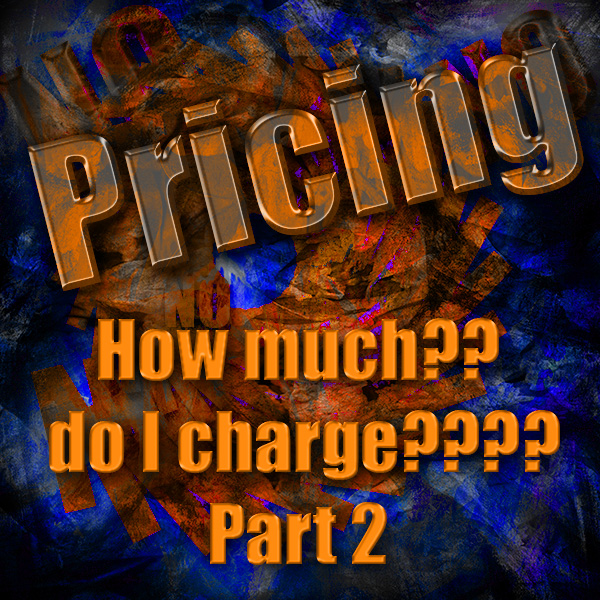
by successfulbob | Guest Post, Marketing Monday, photography
Portrait Pricing Guidelines – Part Two – Marketing Monday
with Steve Bedell
See Part One here
This article is from EPhoto Newsletter, a free bi-weekly newsletter for professional photographers. To subscribe for more great info contact Steve at smbedell@gmail.com.
Mistake number 4: NOT doing in person sales!
First, you have to remember I’ve been doing this since the mid 70’s. How else could we sell except for in person? I’m continually baffled by newbies who have been doing shoot-and-burn are afraid to do IPS.
To me, it makes no sense to do it any other way. If you want to make very little money from each session and not have your client get the beautiful products that they deserve with your professional guidance, post photos online. Then they can see all the photos, send links to every person they know, and not need to purchase a single thing. You just cut your knees off. Go do 10 more jobs for each one you could have done doing IPS.
IPS takes skill. There are many courses and ways available to you, go pick one; that is beyond the scope of this. It requires you to guide your client to choose the best images, discuss retouching, framing and artwork and also choose products that they will enjoy. This is critical if you want with income you deserve for your hard work and skill.

Mistake number 5: Retouching preview prints.
I see photographers online constantly bemoaning the fact that all they do is retouch and they live in front of the computer. Part of it is because they spend time ‘pre-touching’ prints because they don’t believe the client can visualize the final prints. Give them more credit and stop fixing 40 images when they may only buy 3-5. See how much time that saves you.
There may be some instances where the finished print is a composite or has things added for some reason but for routine portraits, you’re wasting a LOT of time.
Mistake number 6: Justifying your price
We’ve all seen the posts that go into great detail about how much it cost to be in business and produce prints. You have overhead, you have insurance, taxes, blah, blah, blah. And when photographers see these posts they all get on the bandwagon and love the post and use it to explain why their 8×10 cost $76.38.
Enough!
When you walk into a Mercedes showroom does the salesman there go through a laundry list of items like new factory they just built, how much health care is costing them, etc? Of course not! It’s a freakin’ Mercedes; you know it cost more because they have BRANDED their products.
Do you ask the jeweler why the Rolex cost more than the Timex? Of course not, they do not address the same market. So stop it!
OWN your pricing! Be proud of it instead of making lame attempts to justify it. Set yourself apart from the mass of bottom feeders who make a mockery of those who choose to excel in this wonderful business that is a mysterious combination of art and science.
I probably wandered off topic, got a little personal and didn’t tighten things up as much as I should have. Maybe I even turned this into a bit of a rant.
But that’s OK, I ain’t no stinkin’ journalism major, I’m a photographer who sees many struggling or moving down the wrong path and with all the help available out there, I’m a photographer who sees many struggling or moving down the wrong path and with all the help available out there, there is just no need for it!
I think it was Charles Lewis who once said ‘Only seek advice from those who are where you want to be.’ So stop asking your brother what he thinks of your pricing or asking your mother what she thinks of your packages. That also goes for asking the photographer who has been in the trenches for six months for their advice.
So just STOP IT. Learn from those who are where you want to be.
Next issue I’ll discuss how your price list should be laid out to get the sales you want. There are some pretty specific guidelines that help your bottom line tremendously.
Steve Bedell has been a professional photographer for over 35 years. He has done weddings, portrait and commercial work but now restricts his business to portraits only.
Steve holds the Master of Photography and Photographic Craftsman degrees from the Professional Photographers of America and is a PPA Approved Print Juror.
commercial work but now restricts his business to portraits only.
Steve holds the Master of Photography and Photographic Craftsman degrees from the Professional Photographers of America and is a PPA Approved Print Juror.
He has been named the New Hampshire Photographer of the Year a record 8 times and in 2011 was awarded the New England Photographer of the Year title. His specialty is natural light portraiture.
He has written hundreds of articles for photo publications, taught classes and workshops nationwide and produced several lighting DVDs. His private newsletter, EPhoto, reaches over 2000 photographers. Steve was a regular contributor to Shutterbug magazine.
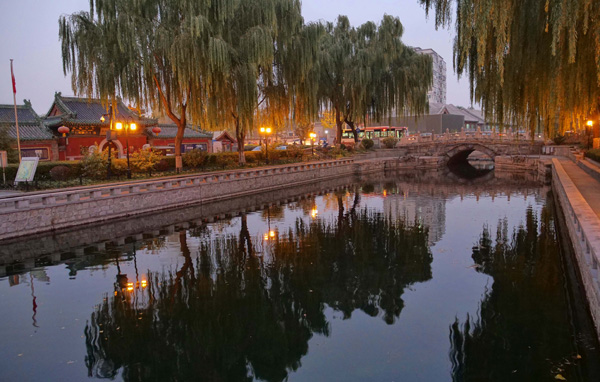
by successfulbob | Guest Post, Lumix G9, travel photography
China Through the Eyes of Ken MacAdams – Part Two
We continue Ken’s story from last Friday. Check out Part One here.
Forbidden City
 This lake is in a barrio outside the Forbidden City. The smog aids in coloration at sunset by diffusing the light. Many walk the pathways by the lake.
This lake is in a barrio outside the Forbidden City. The smog aids in coloration at sunset by diffusing the light. Many walk the pathways by the lake. All Photos in this post © Ken MacAdams 2018 All Rights Reserved
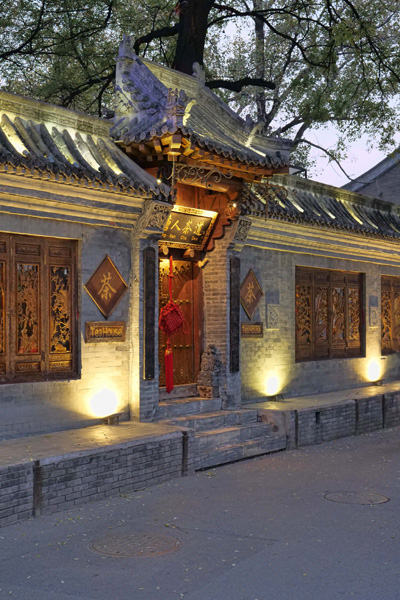 The Chinese take their tea seriously – and to be invited to a tea ceremony is a wonderful experience!
The Chinese take their tea seriously – and to be invited to a tea ceremony is a wonderful experience! When we returned to Beijing, we walked down to the Forbidden City. Once the residence of the Emperor, and strictly off limits to the public, this treasure has been opened up to the public in recent years. It’s a walled city within itself, complete with a moat surrounding it. Within the walls, the Emperor, his wives, concubines, and children all had their appointed places. Only dignitaries or men on official business would be allowed into the great hall just inside the gate, where they could transact business with the Emperor. To facilitate trade from without the city, the Emperor had a canal dug, of which part is still accessible today.
 The Grand Canal and ancient bridge dating back to 1154 A.D.
The Grand Canal and ancient bridge dating back to 1154 A.D. A little Beijing Info
About 1100 A.D. Beijing became the new capital of China, and has remained so until today. The original city wall and gate, along with many other old historic landmarks were destroyed during Chairman Mao’s Cultural Revolution. Today, the city’s population approaches the 30 million mark, and high-rise business and apartment buildings stretch as far as the eye can see. Smog presents an issue here as the government struggles to clean up the old smokestack industries. The mass of automobiles often overpowers the capacities of the highway system and long traffic jams are the norm at morning and evening rush hour. Public buses, taxi’s, and subways do their part to move the masses, and many resort to electric bicycles and scooters as a means of short haul commuting.
Even though we’d been busy hitting the streets, the effects of jet-lag was beginning to set in. We welcomed the quiet of our hotel room as the door clicked closed behind us. A good rest would help us move on to our next destination, the the adventures ahead.
Ken has always loved to travel, so when he made a common connection with the fact that either a long day pounding the streets of some foreign city, or shooting the last dance at a wedding, a good part of his physical

weariness came from lugging around his big heavy DSLR. That’s when he started looking at alternatives – and ended up selecting Panasonic Lumix Micro Four Thirds gear.
Ken is rarely without a camera, and the next great photo travel experience – whether local or abroad – is always in the back of his mind! A longtime resident of the Four Corners, and when he’s not out on the road, he enjoys some of the great outdoor opportunities found there – mountain biking, hiking, and Jeeping.
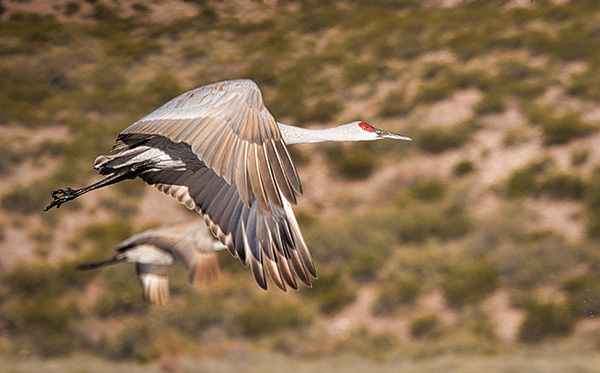
by successfulbob | photography, photography software
Luminar Software Update and Deal
Luminar 3
Some nice things are happening in the Skylum software camp. A new version of Luminar is being polished up for release that includes a Library Module for keeping track of your images. Also, new ‘Looks’ (formerly called presets) are being developed and made available. Here’s the deal. This software is not quite ready for primetime. They are cleaning up bugs and finishing off new features as happens with all new software. But you can get in on the ground floor with a bunch of bonuses (including an extra $10 off if you use the code COATES) This deal will be available through December 19th. You can download Luminar 2018 immediately. I would wait a little bit downloading the Luminar 3 for a little while, but this will get you in on the ground floor pricing.
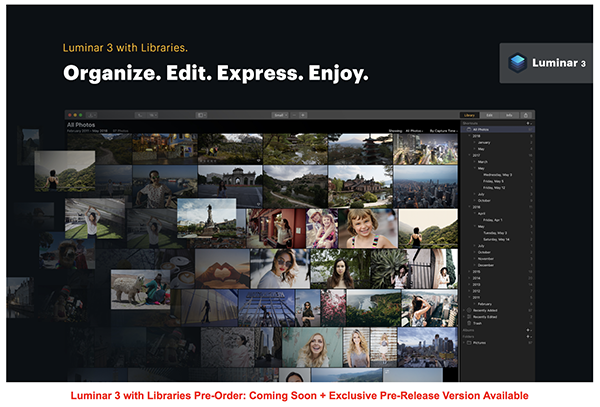
Here’s the skinny.
Luminar 2018 and Luminar three software Gets you to the full info page.
You’ll be able to download Luminar 2018 immediately and start using it. I use it as a plug-in in Adobe Photoshop It adds the capability of 53 filters. Think NIK filters that have even more control than ever. The details enhancer is terrific. Utilizing Artificial Intelligence in things such as enhancing skies, vegetation or just an overall filter I have subtitled “Just make this image look good quick!”
SPECIAL OFFER: Luminar 2018 AI Sky Enhancer + FREE Luminar 3 with Libraries
It’s your double win! Get Luminar 2018 with the all-new AI Sky Enhancer now and update to
Luminar 3 with Libraries for FREE. Plus, you get a bunch of exclusive extras worth US$222!
1) ViewBug: 3-Month Pro Membership (US$42 value)
Join the ultimate photo community for a shot to win prizes, create own challenges, get unlimited
photo uploads, sell your images, enjoy a new website, and much more!
2) KelbyOne: 2-Month Pro Membership (US$40 value)
Supercharging your knowledge with KelbyOne Pro is as easy as pressing the shutter button.
Enjoy free access to weekly courses, private webcasts, creative toolkits, and other freebies!
3) Rocky Nook: Choice of ANY e-book (US$40 value)
Hurry to get your hands on a free eBook by Rocky Nook! Master your techniques, find
inspiration, and hone your craft to create best-looking images!
4) Daniel Kordan: Awesome Landscapes Tutorial (US$80 value)
Need to brush up your skills? We’ve got you covered. Watch extensive tutorials by Daniel
Kordan and create truly jaw-dropping landscape images!
5) Manfrotto, Gitzo, Joby or Lowepro: US$20 Gift card with US$120 purchase (US$20 Value) Looking for extreme savings on your favorite gear? Save US$20 on any purchase over
US$120 from our friends at the Vitec Group.
6) US $300 OFF Iceland Photo Tours (US $300 Value)
Save US$300 on any multi-day (3+ day) Iceland Photo Tours workshop.

Here’s an image processed very quickly in Luminar 2018. AI, Details Enhancer and Crop. It makes the feathers sing.
Yours in Creative Photography, Bob
PS – here’s the link again. Luminar 2018 and Luminar 3 software
Don’t forget the code COATES for the extra 10 bucks off
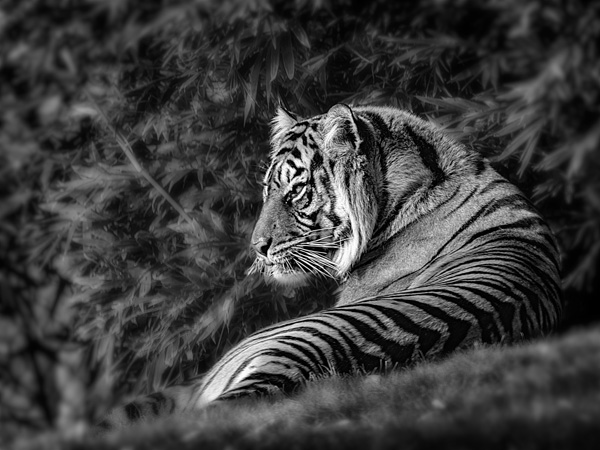
by successfulbob | bird photography, black & white, Lumix G9, photography, photography education, photography gear, wildlife photography
Creating Good Animal Photos from a Captive Environment – Part Two
Last zoo post I was sharing some ideas on learning wildlife photography skills while photographing captive animals. See Part One here
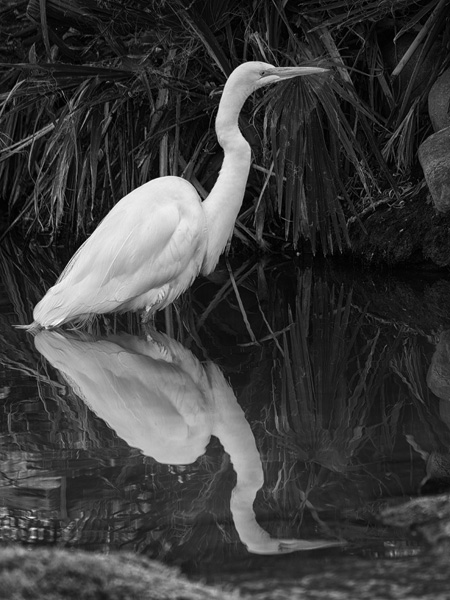 I followed this Great White Egret until the reflection was completed from beak to tail. The black and white treatment brings the bird to the highest contrast attention
I followed this Great White Egret until the reflection was completed from beak to tail. The black and white treatment brings the bird to the highest contrast attention
One of the essential skills is to learn to queue on behavior. This means learning to see when the behavior will change. What will happen when you look at the feathers shaking in a certain way or excrement fall from a bird. These are indicators that signal flight or a change of wing position and either of those can lead to a more interesting photograph.
 Processed this image to BW also. Slight sharpening of the tiger using Skylum software as an Adobe Photoshop plug-in. I also softened the foreground and background with a gaussian blur as well as a darkening Curves layer Significant help for me that increased my ‘keepers’ in photographing images of animals in zoos, parks and in the wild was a lens that has a long reach. The micro 4/3rds Panasonic Lumix system has been an enormous help. Being able to handhold an 800mm equivalent lens makes a huge difference because of the mobility and distance from the animals. The less you disturb your prey and having the ability to still fill the frame is golden.
Processed this image to BW also. Slight sharpening of the tiger using Skylum software as an Adobe Photoshop plug-in. I also softened the foreground and background with a gaussian blur as well as a darkening Curves layer Significant help for me that increased my ‘keepers’ in photographing images of animals in zoos, parks and in the wild was a lens that has a long reach. The micro 4/3rds Panasonic Lumix system has been an enormous help. Being able to handhold an 800mm equivalent lens makes a huge difference because of the mobility and distance from the animals. The less you disturb your prey and having the ability to still fill the frame is golden.
 Don’t lose sight of other opportunities when photographing wildlife. This split tree trunk was good for an abstract look of colors and tones.
Don’t lose sight of other opportunities when photographing wildlife. This split tree trunk was good for an abstract look of colors and tones.
My main camera these days is the Lumix G9. The stabilization system gives an extra six and one-half to seven stops of hand-holdability. This means that hand holding a lens of 800mm equivalent at 1/60th of a second is very possible with sharp results. My favorite lens is a zoom lens – Leica 100-400mm f4.0-6.3
Yours in Creative Photography, Bob
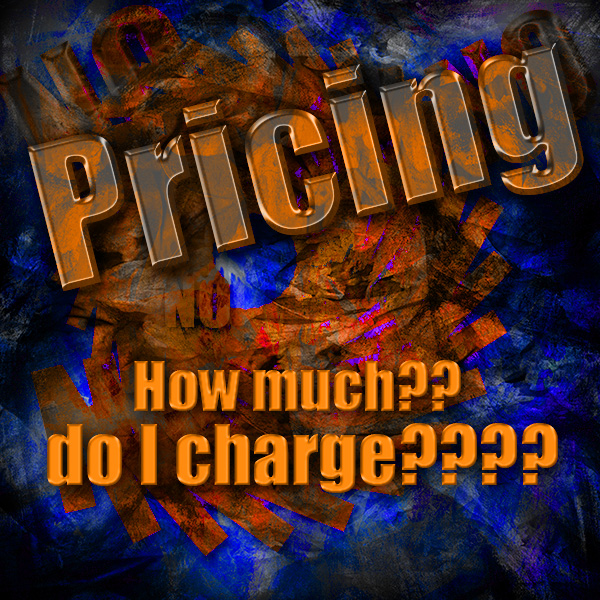
by successfulbob | Guest Post, Marketing Monday, photography
Portrait Pricing Guidelines – Marketing Monday
with Steve Bedell
This article is from EPhoto Newsletter, a free bi-weekly newsletter for professional photographers. To subscribe for more great info contact Steve at smbedell@gmail.com.
Pricing
If you’re like me, you belong to more than a couple of Facebook photography groups. At the end I’ll even list some that I feel are the most valuable.
Reading the posts in these groups is both an education and a frustration. The same questions posted over and over, and then 68 responses from people who may or may not be qualified, but they’re going to chime in anyway.
With that in mind, that brings us to part one: what should your prices be?
I find it hard to believe that people just go on these groups and ask prices like, ‘Hey, how much should I be charging for an 8×10?’ More surprisingly, people will answer something like ‘I charge $45’ or ‘I charge $195’. Wrong answer.
But perhaps my favorite is ‘First, you need to figure your Cost of Doing Business (CODB).’ It used to be that no one took the time to do a few tedious calculations to figure that out and while I can applaud the fact that more people are aware that you actually have to have some kind of idea of what your numbers need to be?
I find it hard to believe that people just go on these groups and ask prices like, ‘Hey, how much should I be charging for an 8×10?’ More surprisingly, people will answer something like ‘I charge $45’ or ‘I charge $195’. Wrong answer.
But perhaps my favorite is ‘First, you need to figure your Cost of Doing Business (CODB).’ It used to be that no one took the time to do a few tedious calculations to figure that out and while I can applaud the fact that more people are aware that you actually have to have some kind of idea of what your numbers need to be in order for you to generate the income you desire, that is NOT the FIRST question you should be asking yourself.

Mistake one: The first question should be ‘Where do I want to position myself in the market?’
You see, all that other stuff is fine but how can you set prices until you define your market and your brand. Do you want to sell unique 30×40 painted portraits for $20,000? Do you want to do school photos for $25 a unit? Do you want to sell prints or files or both? Are you seeing why it makes no sense to figure out COGS and CODB until you define your niche in the market?
You see, all that other stuff is fine but how can you set prices until you define your market and your brand. Do you want to sell unique 30×40 painted portraits for $20,000? Do you want to do school photos for $25 a unit? Do you want to sell prints or files or both? Are you seeing why it makes no sense to figure out COGS and CODB until you define your niche in the market?
With that taken care of, let’s go ahead and address some other pricing issues that make my head boil every time I see them.
Mistake number 2: Starting out at a low price to get business and raising it later.
Big mistake. Later won’t ever come unless you move to another city and start with new clients because you’ve already branded yourself at a certain price level. Work for FREE until you feel your work commands the price you want and then start charging. It’s far harder to dig out of a hole than to start out where you want to be. If you need to do another job or earn income some other way, do it.
Mistake number 3: Selling files, or selling files and prints.
OK, I expect some will disagree with me here but hear me out. I know MANY successful photographers who make a great living selling wall prints and other print products. While there are probably some, I don’t know any who make a great living selling files.
Here is the part I don’t understand. If we sell artwork, we can command a decent price for it. And we can sell many copies of it. I had a client a couple of years ago for an extended family portrait session. She bought $4500 worth of 5×7’s! And I ran into her at the beach one night while I was doing a family portrait and she was there with some family members in beach clothes and she asked if I could take photos of them when I was done with my family. I said sure. She ordered another $2200 worth of 5×7’s from those super casual beach photos!
That’s almost $7000 worth of 5×7’s from 2 files. Imagine if I sold that file for $300. I’d have $600 instead of $6700. How much more work would I have to do to sell files to make that amount? What if I gave them the file with each print they ordered, like some photographers do? I’d still be WAY under!
More from Steve next Monday!
Steve Bedell has been a professional photographer for over 35 years. He has done weddings, portrait and commercial work but now restricts his business to portraits only.
Steve holds the Master of Photography and Photographic Craftsman degrees from the Professional Photographers of America and is a PPA Approved Print Juror.
commercial work but now restricts his business to portraits only.
Steve holds the Master of Photography and Photographic Craftsman degrees from the Professional Photographers of America and is a PPA Approved Print Juror.
He has been named the New Hampshire Photographer of the Year a record 8 times and in 2011 was awarded the New England Photographer of the Year title. His specialty is natural light portraiture.
He has written hundreds of articles for photo publications, taught classes and workshops nationwide and produced several lighting DVDs. His private newsletter, EPhoto, reaches over 2000 photographers. Steve was a regular contributor to Shutterbug magazine.

 commercial work but now restricts his business to portraits only.
Steve holds the Master of Photography and Photographic Craftsman degrees from the Professional Photographers of America and is a PPA Approved Print Juror.
commercial work but now restricts his business to portraits only.
Steve holds the Master of Photography and Photographic Craftsman degrees from the Professional Photographers of America and is a PPA Approved Print Juror.



















